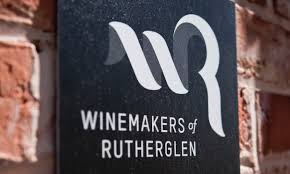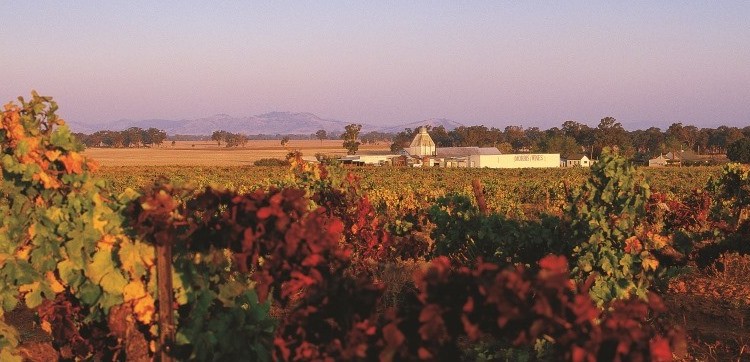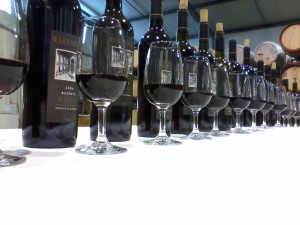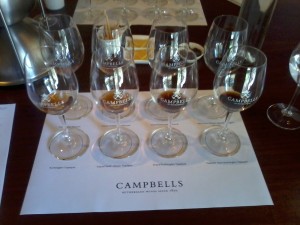 ‘Dig gentleman dig, but no deeper than six inches, for there is more gold to be won from the top six inches than from all of the depths below’
‘Dig gentleman dig, but no deeper than six inches, for there is more gold to be won from the top six inches than from all of the depths below’
Lindsay Brown of ‘Gooramadda Run’
In the late 1870’s and early 1880s Victoria reigned supreme as the capital of Australian wine so much so that it produced about two-thirds of the country’s wine, two thirds of which was Rutherglen’s contribution. Rutherglen was the vinous epicentre of colonial Australia. It “seemed that the future of the wine industry in Victoria lay within the northern districts” said David Dunstan in his 1989 book Morris of Rutherglen – Five Generations of Winemakers.
“The cooler, more southerly areas fell out of fashion as grape growing regions” as many a fledging Melbourne vineyard planted on prime real estate succumbed to the land boom of the 1880’s. Today, in stark contrast, cool climate wines are swirled, sniffed, sipped and savoured with alacrity by show judges and sommeliers alike – often in preference to those of warmer, inland regions like Rutherglen.
Since the late 1980s the pendulum has swung the other way, the “southerly areas” have struck back and pinot noir, though accounting for a minuscule 2% of Australia’s total crush, has captured the vinous imagination, its burgeoning popularity confirmed when the Mornington Peninsula’s 2012 Yabby Lake pinot noir won the 2013 Jimmy Watson Memorial Trophy – a first for a pinot. Even cool climate shiraz was getting in on the act when a Glaetzer-Dixon 2010 Mon Père Shiraz from Tasmania took out the same trophy in 2011.
As the urbane Max Lake said way back in 1966 “Victorian wines have waxed and waned since their origin in 1838” – be they cool climate or otherwise – and trying to foretell wine styles is akin to predicting fashion trends.
He continued: “According to the cool (climate) brigade it is impossible to make white table wines in this area, yet Mick Morris seems to achieve the impossible year after year. His chardonnays have disgraced many wines from the theoretically right areas. This wine usually reaches the marketplace with a price tag that is half that of its competitors and a quality that is sometimes twice as good.” What applied in 1966 is true today.
There’s a lingering misconception that Rutherglen is a one- wine -style wonder still heavily reliant on its implacable reputation for crafting the renowned, quintessentially Australian liqueur muscats, topaques and fortifieds, supplemented by big, gutsy reds “fit for heroes” and ageing baby boomers.
The inference being that today’s Rutherglen is, in part, a victim of its own ‘fortified’ success at the expense of its emerging table wines which are often overlooked by the modern gatekeepers of vinous fashion.
I suspect many sommeliers remain ignorant of both the region’s fortified and table wines, unforgiveable in regard to the former and, sadly understandable regarding the latter as such are often tasted with cool-climate orientated palates.
This may well be compounded by the assumption that the likes of Rutherglen’s luscious liquid gold muscats are so universally acclaimed and well known that they literally sell themselves.
Nothing could be further from the truth on both counts. Firstly Rutherglen is home to a growing number of quality table wines and secondly younger generations remain unaware of its magnificent fortifieds.
It is easy to be seduced by Rutherglen’s rich, romantic and colourful past however as Warrabilla’s Andrew Sutherland Smith realistically says “people don’t give a jot about the history of the place – they want to enjoy what’s in the glass in front of them now”.
So let’s take a fresh look at today’s Rutherglen with both a nod to the past and an eye to the future. Where to start? Tempted as I am to commence by extolling the virtues of its muscats, topaques and Australian-style ports, I’m tipping the pyramid on its head to focus on table wines first and to finish on fortifieds. And in between talk about some of its viticultural and vinicultural rising stars who are reinvigorating what Max Allen calls “this marvellous old region ….that deserves to be canonised for its services to wine.”
While many have eloquently and evocatively shone a light on Rutherglen’s magnificent muscats and luscious liqueur wines, few have illuminated its hitherto oblique and largely undiscovered table wines.
So here goes!
New Age Durif
Without doubt durif, in all its guises is Rutherglen’s signature red, and provided its blocky, crunching tannins can be tamed, it’s assured of a good future.
To some, Mick Morris included, durif is ‘shiraz on steroids’ – it is unmistakably inky, unequivocally rich and unashamedly robust with a coiled-up, brooding intensity and tenacious tannins that reward cellaring.
But it’s a mistake to think all Rutherglen durif is the same, not so. These days it’s much more nuanced with subtle variations in style, structure, finesse and fruit evident in both the vineyard and the winery.
Within this spectrum the challenge is to make a more readily accessible, drink-now style to complement the gutsy but nonetheless appealing cellar wines of the past – without sacrificing the wine’s inherent varietal characteristics.
One way of achieving this is to soften the tannins and let the rich, spicy, chocolate and liquorice fruit speak for itself – easier said than done, but eminently possible, if the vertical tastings of Morris durif from 1990 to 2013 and Warrabilla durif from 2001 to 2013 I did recently are a guide.
Vintage variation aside, common to both tastings was the development of integrated tannins as the years progressed coupled with more subtle structure, better oak and more vibrant fruit. Unsurprisingly, there is a discernible move in many of Rutherglen’s latter vintages toward elegance, not a term I readily associate with durif.
Yes, durif still polarises opinion – it’s a style you either love or hate – but sadly many dismissively condemn it without giving it a fair trial and to the unsuspecting it often gets mistaken for cabernet. It’s a big, dry, spicy autumnal come wintery red ideally suited to game and red meat. It’s also the style of wine Robert Parker waxed lyrically about in the early 1990’s in helping put Aussie reds on the map. Parker could just as easily have been talking about big Rutherglen reds as opposed to their Barossa cousins.
Sourced from Montpellier it arrived in Rutherglen in 1908 as part of the post phylloxera plantings courtesy of Francois de Castella and owes its modern day revival in the early 1950s to Keith Gayfer and Mick Morris, the latter having first planted it in 1920. It was not until about 1950 that Mick started selling it.
With alcohol levels hovering around 14-15% ABV, and in some cases a tad more, Rutherglen durif is no wall flower. Warrabilla’s unrestrained 2004 Warrabilla Parola’s Durif comes in at 17.5% ABV – the antithesis of a wussy wine.
In this politically sensitive age when wine risks being dragged into the anti-alcohol debate – and organisations like Wine in Moderation are struggling to ‘defend’ wine’s perceived role in excess alcohol consumption – big, high alcohol durifs stand out like sore thumbs.
The indefatigable Chris Pfeiffer, to whom the region owes much, thinks Rutherglen needs to be careful about alcohol given an emerging new era bordering on wowserism. Chris believes high alcohol table wines are in the spotlight, and though some winemakers can make balanced wines with high alcohol, there is a growing backlash against them, led by the health lobby.
Balanced wines with high alcohol are Andrew Sutherland Smith’s forte, he has nailed his reputation to the mast by producing some magnificently mouth-filling but nonetheless controversial high alcohol durif of which the 2006 and the 2009 stand out, the latter literally wraps itself around your palate and gives you a big hug!
And the aforementioned 2004 Warrabilla Limited Release Parola’s Durif is a hummer of a wine with its dark chocolate, spice, cherries and liquorice. Its balance and opulence is all about mouthfeel rather than alcohol. Besides there is some elasticity when it comes to declaring the exact amount of alcohol content on labels.
Other durifs of note include Campbells LR 2012, Cofield’s 2012 vintage, Ross Gehrig’s 2010, Rutherglen Estates 2009 Renaissance Reserve and Scion’s 2013. Scion also make an unconventional aromatic, medium-bodied 2012 Durif-Viognier blend.
Durif aside, Rutherglen has long been home to some fine shiraz as epitomised by Damien Cofield’s silky 2012 Minimal Footprint Quartz Vein shiraz and his delectable 2013 Sparkling shiraz, long a weakness of mine. Then there’s Campbells ubiquitous 2012 Bobbie Burns Shiraz and Mandy Jones’s stunning old vine 2012 Jones Winery & Vineyard L.J Shiraz (with 5% Grenache).
Where would we be in Australia without Shiraz? Pretty much everyone who is anyone in Rutherglen and beyond has an affinity with it – it’s the vinous equivalent of the Opera House.
As for sparkling reds, including shiraz and durif and blends thereof (of which Anderson, Campbells, Cofield, Morris and Mount Prior are standouts) Rutherglen is up there with Great Western and McLaren Vale in regard to quality, finesse and consistency. The Anderson 2006 and 2002 Cellar Block Sparkling Shiraz being the pick of the crop in aged vintages, and these are closely followed by the younger Cofield 2013.
Also Jones Winery’s 2011 & 2013 Malbec challenges Langhorne Creek’s claim as the home of Aussie Malbec, and expect to see top Malbec from Campbells and Cofield soon. As for cabernet, a challenging variety to make in Australia, Warrabilla’s 2013 Limited Release Parola’s Cabernet (made by Amy Sutherland Smith) stands out as do Jen and Chris Pfeiffer’s stylish cabernets.
Rutherglen’s evolving, new wave whites are harder to pin down. Their future rests very much with the younger generation vignerons who are crafting some imaginative, appealing Rhône straight varietals and blends.
Though not of the younger generation, the urbane Colin and energetic Malcom Campbell, whose individual and collective contribution to the region is inestimable, have long made consistently fine wines and their collective savvy is apparent in the 2013 Limited Release (LR) Viognier and 2013 LR Rousanne, both beautifully balanced wines of finesse and pristine fruit flavour.
Likewise, the talented Marc Scalzo’s Rutherglen Estates’ 2013 Shelley’s Block Marsanne-Viognier blend is exceptional, as is his 2012 Viognier and 2013 Marsanne. Marc is another rising star.
‘Rhône rangers’ aside, Italian varietals like Arneis, Biancone, Fiano and Pinot Grigio are starting to pop their heads up as the young guns continue to experiment, innovate and source fruit from adjoining regions like Beechworth and the Alpine Valleys. There is a growing, mutually beneficial synergy among the younger Rutherglen and Beechworth vignerons.
Rutherglen has enjoyed a long history of continuous multi-generational, family wine making which brings with it mixed blessings. On the one hand it has meant stability continuity, wisdom and experience. On the other, it has at times stifled innovation, diminished regional brand awareness and competitiveness and subconsciously created an over reliance on its famous fortifieds. Hence there have been many false dawns and impending revivals on route to a genuine lasting renaissance capable of capturing the younger Gen Y and Millennial wine market essential to its future.
For example some like Chris Pfeiffer, who came to Rutherglen as distinct from being born there, argue that Rutherglen lost an opportunity when creating the Geographical Indicator (GI) by not extending the area significantly. (Incidentally Australia boasts 65 wine regions). While others suggest that the region may have benefited by replicating the visionary Brown Brothers at Milawa – by sourcing fruit from far and wide.
Ross Gehrig, perhaps the rising star among many, is making some splendid wine from both indigenous and externally-sourced fruit, of which his 2011 Riesling, 2011 Chenin Blanc, John Ox (John of Oxley) 2008 Lagrein, 2010 Durif and 2011 Gamay are examples.
My abiding impression of today’s Rutherglen is that its future is bright given the energy, creativity and entrepreneurial talent of its younger vignerons and the savvy and experience of its older ones.
James Halliday describes the former as Rutherglen’s ‘Young Bloods, the newest generation of men and women with wine in their veins, the sons and daughters of third or fourth generation winemakers.’
According to Jen Pfeiffer these ‘Young Bloods’ are using a variety of different winemaking techniques including extended skin contact post-fermentation, extended barrel maturation and picking at a wide baume range – and these techniques are helping to modernize the region’s wine style and keep it relevant to today’s consumer.
Forget about ‘Team Australia’ – focus on ‘Team Rutherglen’, it oozes with talent: Mandy Jones, Ross Gehrig, Damien Cofield, David Morris, Marc Scalzo, Jen Pfeiffer, Stephen and Michael Chambers, Andrew and Amy Sutherland Smith, Rowly Milhinch, Anton Therkildsen, Howard Anderson, Suzie Campbell and Chloe Earl. Maybe one day David Morris’s son Madden will make wine alongside him, should he choose to.
Also there’s an influential matriarchy that’s quietly helping transform Rutherglen’s once blokey image, though yet to reach the dizzy heights of Champagne’s Grandes Dames, the likes of Wendy Killeen, Jan Milhinch, Mandy Jones, Jen Pfeiffer, Eliza Brown and Christobelle Anderson are individually and collectively making their mark.
Wendy Killeen, with the help of viticulturalist Ruston Prescott and winemaker Andrew Drumm, is busy revitalising Stanton & Killeen and intends using her extensive Iberian Peninsula varietal plantings including Tinta Roriz, Touriga Nacional, Tinta Cao, Tinta Barroca and Souzao to make fine table wines.
Finally, keeping the best to last, a word on what Max Allen calls Rutherglen’s twin peaks – muscat and topaque. Trying to describe the hedonistic, lingering, gob-smacking palate sensation of a rare Rutherglen fortified is like trying to describe a beautiful painting or a Darwin sunset over water to a blind person – it’s a subliminal experience – and once enjoyed it stays with you seemingly forever.
Of the two hundred or so Muscat varieties the only one used to make Rutherglen Muscat is Muscat à petit grains Rouge, or Brown Muscat, as it’s more commonly known.
The traditional sextet of Morris, Chambers Rosewood, Campbells, Stanton & Killeen, Buller and All Saints are Rutherglen’s fortified flag bearers with Scion putting a new twist on things with its 2012 Muscat Nouveau and Chris and Jen Pfeiffer introducing the delights of apera (formerly Australian sherry) to the uninitiated.
Of these, Morris and Chambers Rosewood are my favourites however Campbells’ muscat and topaque have both noticeably improved of late to equal Rutherglen’s best. The Muscat classifications of 1995-96 whereby Rutherglen Muscats were classified into four distinct categories denoting their progression in richness, complexity and flavour intensity was a masterstroke. It provided a benchmark or standard whereby consumers could undertake meaningful comparative tastings with confidence.
My enduring memory of Rutherglen is sampling a pre-phylloxera Morris fortified, it was so thick and treacly-like, it struggled to get out of the pipette.
If you intend visiting I recommend trying both Taste Restaurant (replete with microbrewery) in Main Street, and the Pickled Sisters Café at Cofield Winery, Distillery Road Wahgunyah.
Today’s Rutherglen has much to offer the adventurous imbiber, including an array of fine cellar door only and back-vintage table wines like the honeyed, nutty Cofield 2005 Reserve Release Sparkling Pinot Noir-Chardonnay, Ross Gehrig’s (John Gehrig Wines) 2012 Pinot Noir, and Andrew Buller’s textural, multi-layered 2010 Mondeuse.
Sadly, Buller Wines of Rutherglen will not be the same now that Andrew, ever the gentleman, is no longer there, let’s hope he is back making fine wine in Rutherglen very soon.
I wonder how long it will be till a durif from Rutherglen wins a Jimmy Watson Memorial Trophy.
Best leave the last word to The Age newspaper’s Jeni Port ‘Rutherglen – Full of Flavour’ – it encapsulates Rutherglen and North East Victoria to a tee.
_________________________________________________________________________
Originally published in Alquimie, Edition Five, Second Quarter 2015




